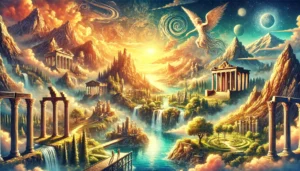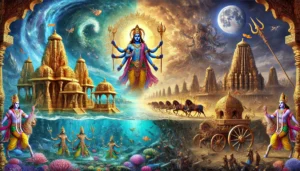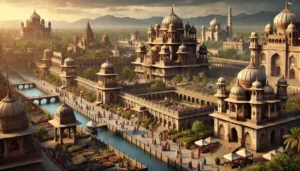
Tracing Mythological Locations
Exploring Real Places from Ancient Legends
Mythology has long been a source of fascination for humanity, offering tales of divine intervention, epic battles, and moral lessons. Within these narratives, locations like Dwaraka, Lanka, and Kurukshetra emerge not just as mythical settings but as places that might have once existed. Over the centuries, explorers, historians, and archaeologists have sought to trace these sites, attempting to bridge the gap between legend and reality. This article delves into the real-world quests to locate some of the most iconic places from Indian mythology, blending faith, historical analysis, and modern technology.
“Kurukshetra: The Battlefield of the Mahabharata”
Mythological Context
The battlefield of Kurukshetra, where the climactic war of the Mahabharata unfolded, is deeply intertwined with Indian culture. It is at this place that the Bhagavad Gita was delivered by Lord Krishna, guiding Arjuna through his moral dilemma. The region is described in the Mahabharata as a sacred land, chosen for its spiritual significance and central location.
Historical and Geographical Evidence
Kurukshetra is identified with the modern-day district of the same name in Haryana, India. The region is rich in archaeological sites, ancient temples, and water bodies mentioned in the Mahabharata, such as Brahma Sarovar and Jyotisar, believed to be the spot where Krishna delivered the Gita.
Excavations and Artefacts
Archaeologists in the region uncovered pottery, tools, and other artifacts from the Painted Grey Ware (PGW) culture through archaeological excavations. These findings date back to around 1200–600 BCE and align with the estimated time of the Mahabharata. Although these discoveries do not directly prove the historicity of the epic, they suggest that advanced societies inhabited Kurukshetra during this era.
Cultural Continuity
Kurukshetra has remained a center of pilgrimage for centuries, preserving its association with the Mahabharata. Annual festivals, rituals, and fairs keep the legacy of the battlefield alive. This continuity of tradition strengthens the case for its historical significance.
Table of Contents

“Dwaraka: Krishna’s Golden City“
Mythological Context
Dwaraka, as described in the Mahabharata and the Bhagavata Purana, was the opulent kingdom of Lord Krishna. It was built by divine architects and situated near the sea, and it was said to be a marvel of its time, with sprawling palaces, intricate architecture, and vibrant markets. The legend concludes with the city being submerged into the ocean after Krishna’s departure, marking the end of the Yadava dynasty.
Archaeological Discoveries
The search for Dwaraka led to discoveries off the coast of Gujarat, near present-day Dwarka. In the 1980s, marine archaeologists from the National Institute of Oceanography (NIO) unearthed structures submerged underwater. These included walls, bastions, and rectangular stone anchors, suggesting the existence of a port city.
Carbon dating and other methods have suggested that these structures might belong to 1500 BCE or earlier, aligning with the period traditionally associated with Krishna. Additionally, ancient texts like the Skanda Purana and Harivamsa Purana provide geographical descriptions that match this region.
While the exact link between Krishna’s Dwaraka and the archaeological site remains debated, the evidence strongly indicates the existence of an ancient and advanced coastal settlement, possibly inspiring the legend.
Challenges and Ongoing Research
Establishing a definitive connection between the ruins and Krishna’s Dwaraka requires researchers to find more robust evidence. The shifting coastline, rising sea levels, and erosion have presented challenges to the quest. Despite these hurdles, advancements in underwater exploration technologies hold the potential for uncovering new revelations.
“Ayodhya: Rama’s Birthplace”
Mythological Context
Ayodhya, which is the birthplace of Lord Rama, holds a significant place as one of the seven sacred cities in Hinduism. The Ramayana depicts Ayodhya as a city adorned with grandeur, featuring palaces, gardens, and bustling streets.
Archaeological Discoveries
The identification of Ayodhya with the modern town in Uttar Pradesh has been widely accepted. Excavations by the Archaeological Survey of India (ASI) have revealed evidence of ancient settlements beneath the disputed Ram Janmabhoomi site, including brick structures and terracotta figurines. These findings date back to the Gupta period and earlier, suggesting Ayodhya’s antiquity as a thriving urban center.
Ram Janmabhoomi Controversy
The site’s association with Rama’s birthplace has been a subject of intense debate and conflict. In recent years, the construction of the Ram Mandir has reignited interest in Ayodhya’s historical and mythological significance, drawing pilgrims and researchers alike.

“Lanka: Ravana’s Fortress”
Mythological Context
Lanka is portrayed as a golden city ruled by the demon king Ravana in The Ramayana. It was built by the celestial architect Vishwakarma and was a city of unmatched grandeur, with soaring towers, palaces, and gardens. Hanuman’s daring leap across the ocean to Lanka and the subsequent battle to rescue Sita are described in the epic.
Possible Locations
Several places have been proposed as the mythical Lanka, with most theories centering on Sri Lanka. The island’s proximity to India and its historical references to Ravana have fueled these claims.
Adam’s Bridge (Ram Setu)
One of the most intriguing pieces of evidence linking Sri Lanka to the Ramayana is Adam’s Bridge, also known as Ram Setu. This chain of limestone shoals connects India’s Rameswaram to Sri Lanka’s Mannar Island. Satellite imagery has revealed its peculiar structure, which some believe to be a man-made or modified feature. The Ramayana describes the construction of a bridge by Lord Rama’s army of vanaras (monkey-like beings) to reach Lanka, leading many to associate Adam’s Bridge with this tale.
Ravana’s Palaces and Caves
Sites linked to Ravana in local folklore can be found all over Sri Lanka. The Sigiriya rock fortress, with its advanced urban planning, has been speculated by some as a possible remnant of Ravana’s kingdom, although mainstream historians date it to the 5th century CE. Other locations, such as Ravana Ella caves and Sita Eliya, are part of local traditions that tie them to the epic.
Archaeological Evidence
While ongoing archaeological excavations in Sri Lanka continue to shed light on its ancient history, they have yet to find definitive evidence of Ravana’s Lanka. These findings, which are not directly linked to the Ramayana, hint at advanced civilizations that might have inspired the epic’s descriptions. The excavations are expanding our knowledge of the region’s past.

“Hastinapur: The Capital of the Kauravas”
Mythological Context
Hastinapur, the capital of the Kauravas and Pandavas, played a central role in the Mahabharata. It was the seat of power, intrigue, and the events leading up to the Kurukshetra war.
Archaeological Evidence
Archaeologists studying modern-day Hastinapur in Uttar Pradesh have uncovered evidence of settlements from the PGW culture, including pottery, tools, and other artifacts. These excavations support the Mahabharata’s descriptions of Hastinapur as an ancient city. The findings reveal a deep connection between the archaeological evidence and the historical accounts of the city as a bustling urban center in ancient times.
Geological Changes
The Mahabharata mentions a flood that led to the abandonment of Hastinapur. Geological studies have suggested that changes in the course of the Ganges River might have caused such an event, lending credence to the epic’s narrative.
“Bridging Mythology and History”
Explorers and historians uncover mythical sites for more than just validating ancient texts; they also delve into cultural identity and heritage. These stories, passed down through generations, have shaped the beliefs and traditions of millions. Through the examination of these tales using the perspectives of history, archaeology, and science, we gain a deeper understanding of the past.
“Challenges in Interpretation”
Lack of Definitive Evidence:-
Many findings remain circumstantial, requiring careful interpretation.
Oral Traditions and Variations:-
Myths often evolve over time, complicating efforts to pin down exact locations.
Cultural Sensitivities:-
The intertwining of mythology with religion makes objective study challenging in some cases.
“Role of Technology”
Modern tools like satellite imagery, ground-penetrating radar, and underwater exploration are revolutionizing the search for mythical sites. These technologies have already provided insights into places like Dwaraka and Ram Setu, paving the way for further discoveries.
Conclusion
Tracing the real locations from mythology becomes a journey that transcends the boundaries of faith and science. Each discovery brings us closer to understanding the cultural and historical roots of these timeless tales, whether it is the submerged ruins of Dwaraka, the sacred battlefield of Kurukshetra, or the enigmatic Lanka.
‘While definitive proof may remain elusive, the pursuit itself is seen as a testament to humanity’s enduring curiosity and reverence for the past. Ancient wisdom is blended with modern research, and the mysteries of our shared heritage are continued to be unraveled, connecting mythology to the tangible world around us.’
FAQs: Tracing Mythological Locations – Exploring Real Places from Ancient Legends
Q1: What is the purpose of tracing mythological locations?
Tracing mythological locations helps bridge the gap between ancient stories and real-world geography. It brings a deeper understanding of cultural heritage, revealing how myths may have been inspired by real places.
Q2: Can mythological locations be historically verified?
While some places, like Dwarka or Ayodhya in India, have archaeological evidence, others remain symbolic. Myths often intertwine with history, making it difficult to establish definitive proof.
Q3: How do researchers identify mythological sites?
Researchers use ancient texts, oral traditions, geographic descriptions, and modern tools like satellite imagery and archaeological surveys to locate and study these sites.
Q4: Are these locations still relevant today?
Yes, many of these sites are culturally and spiritually significant, attracting pilgrims, tourists, and history enthusiasts. They also provide insights into ancient civilizations and their worldviews.
Q5: What are some famous examples of mythological places linked to real locations?
Examples include Mount Olympus (Greece), Lanka from the Ramayana (identified with Sri Lanka), and the River Saraswati (India, now believed to be dried up).
Q6: Why is there skepticism about these locations?
Skepticism arises because myths often feature supernatural elements, making their historical authenticity questionable without tangible evidence.
Q7: How can one explore these sites?
Travel to well-documented locations, study ancient texts, and participate in guided archaeological tours. Online resources and documentaries are also valuable for remote exploration.
Tracing mythological locations is a fascinating journey through time, blending mythology, history, and science to uncover humanity’s shared stories.
Unlock the Ancient Wisdom of Sanatan Dharma – Join Us on YouTube!
👉 Subscribe now to Prachin Sanatan Dharma and embark on a journey of enlightenment.
Explore timeless teachings, spiritual insights, and cultural richness on our YouTube channel, Prachin Sanatan Dharma. Dive deep into the essence of Sanatan Dharma through captivating videos that inspire and educate.
Related Articles
- Restful Nights: Ayurvedic Remedies and Traditional Indian Practices to Overcome Insomnia and Late-Night Habits
- The Tridevi: Lakshmi, Saraswati, and Parvati – Their Roles and Powers
- “Divine Creatures of Ancient Indian Scriptures: Exploring the Role of Animals in the Vedas, Puranas, and Mahabharata”
- Nature and Spirituality: Exploring the Sacred Essence of the Himalayas, Ganga, and Other Natural Wonders”
- “Reviving the Gurukul System: Relevance and Lessons for Modern Education”
- “Exploring Greek and Indian Mythology: Similarities Between Greek and Indian Mythology “
- “Embracing Sattvic Living: Harmonizing Mind, Body, and Soul Through Food and Lifestyle”
- “Charity and Prosperity: Exploring the Concept of Daan and Its Financial Relevance in Modern Life”
- How to Build an Eco-Friendly Home Inspired by Vastu Shastra
- Comparison of Ancient and Modern Sports: How Traditional Sports Have Influenced Contemporary Games
- “Timeless Lessons from Ancient Tales: Linking Samudra Manthan and Ganga’s Descent to Modern Ecological Challenges”
- “Reviving Sanskrit: How AI is Preserving Ancient Languages for the Future”
- “Mathura: The Sacred Land of Lord Krishna’s Divine Leelas”
- Investing for Future Generations: Lessons from Indian Traditions on Legacy Building and Wealth Preservation
- “Ancient Indian Wisdom: Timeless Lessons for Tackling Today’s Climate Crisis”
- “Artificial Intelligence and Spirituality: Transforming Ancient Practices for the Modern World”
- “Gold and Real Estate in India: Timeless Assets Shaping Financial Strategies”
- Tradition Meets Innovation: The Evolution of Technology in Hindu Rituals
- End-of-World Myths: Exploring Kali Yuga in Hinduism and Ragnarök in Norse Mythology
- Garuda, Pegasus, and Dragons: The Universal Ties of Mythical Beasts Across Cultures
- “Ancient Vimanas: Mythical Flying Machines or Evidence of Advanced Technology?”
- Time Travel in Hindu Mythology: The Fascinating Tales of Kakudmi and King Raivata
- “Divine Feminine Power in Hindu Mythology: The Legends of Durga, Saraswati, and Lakshmi”
- “Divine Beings of Sanatan Dharma: The Spiritual Significance of Sacred Animals in Hinduism”
- “Symbolism in Mythological Art: Unlocking Hidden Meanings in Ancient Temple Carvings”
- “Exploring Technological Advancements in Ancient India and Civilizations: Vimana, Metallurgy, & Water Management systems”
- Unveiling the Mysteries: Ancient Temples of Sanatan Dharma , Mysterious Temples of India
- “The Scientific Knowledge of Sanatan Dharma: Ancient Wisdom Meets Modern Science”
- Ancient Indian Sports and Games: Celebrating a Legacy of Skill, Strength & Strategy”
- “Exploring the Cosmic Link: The Connection Between Astronomy and Vedic Astrology”
- The Power of Sanskrit: Unlocking the Divine Language of the Gods
- “The End of Kaliyuga: A Sanatan Insight into the World’s Final Chapter”
- Explore more articles on Prachin Sanatan Yuga.
mythology mythology mythology mythology mythology mythology mythology mythology mythology mythology
Tracing Mythological Locations Tracing Mythological Locations Tracing Mythological Locations Tracing Mythological Locations Tracing Mythological Locations Tracing Mythological Locations Tracing Mythological Locations Tracing Mythological Locations Tracing Mythological Locations Tracing Mythological Locations Tracing Mythological Locations Tracing Mythological Locations Tracing Mythological Locations
Tracing Mythological Locations Tracing Mythological Locations Tracing Mythological Locations Tracing Mythological Locations Tracing Mythological Locations Tracing Mythological Locations Tracing Mythological Locations Tracing Mythological Locations Tracing Mythological Locations Tracing Mythological Locations Tracing Mythological Locations Tracing Mythological Locations Tracing Mythological Locations
